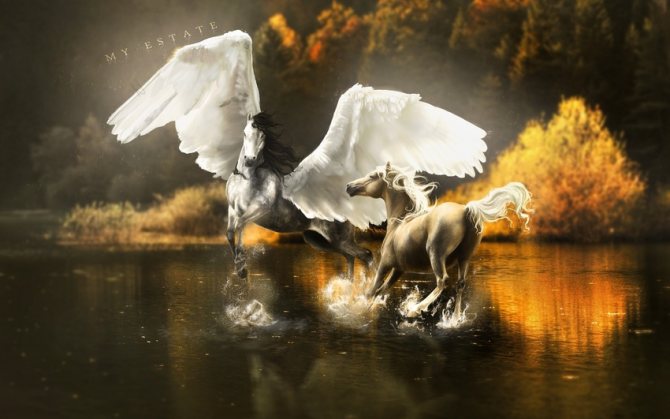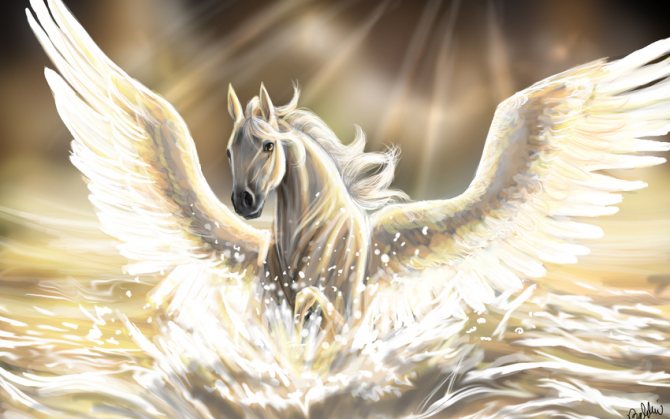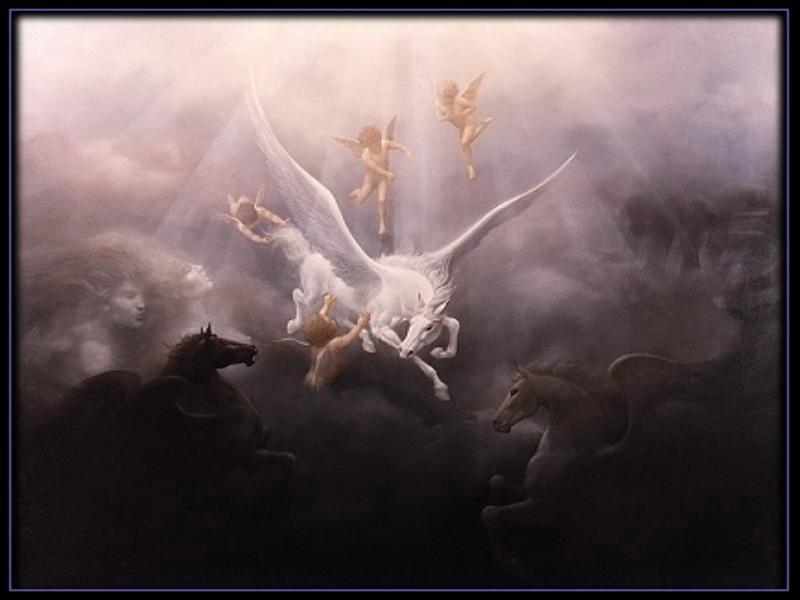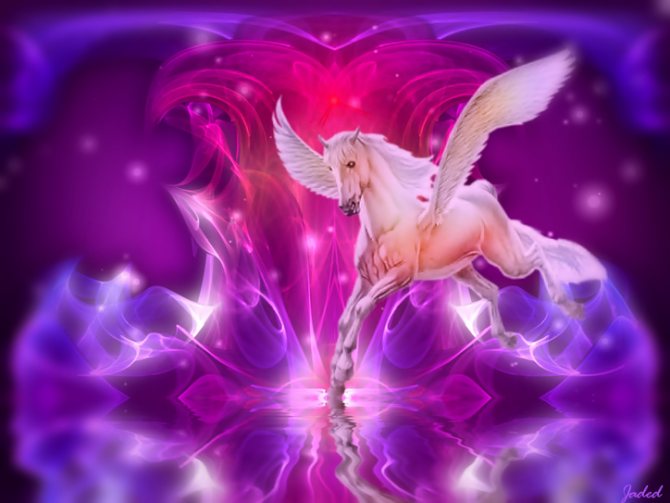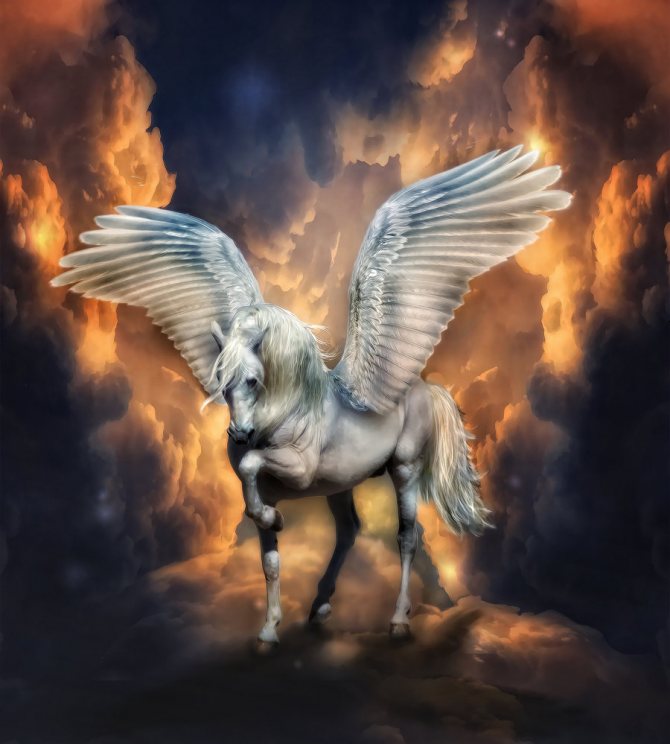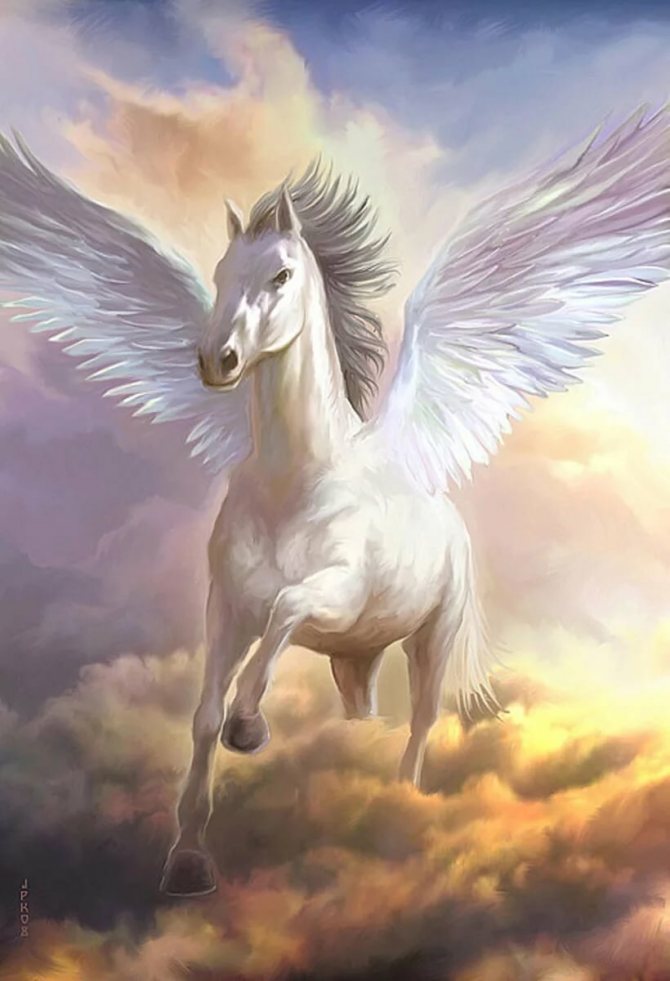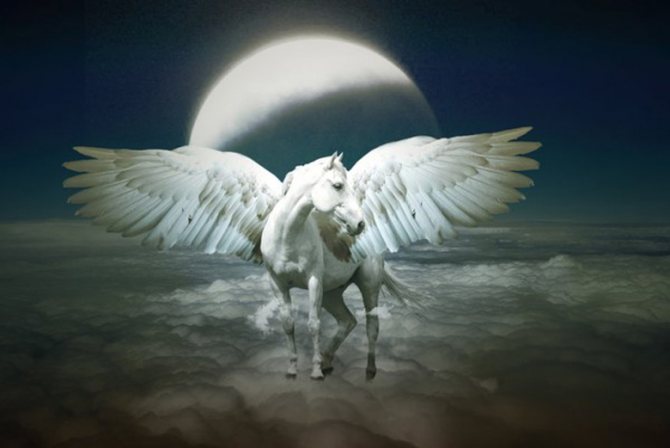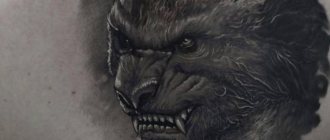Pegasus is an amazing creature from ancient Greek myths.
Since ancient times Pegasus has been a symbol of success, inspiration, glory. Poets and singers of ancient Greece considered him their patron. Even centuries later, the image of Pegasus is still found on emblems. For example, during World War II the winged horse decorated the badge of the British Airborne Troops.
The story of his emergence into the world is described in the myths of the ancient Greeks, and it is distinguished by unusual details and involvement in the plot of the famous legend. Who was Pegasus? How he was seen in ancient times? What did meeting him give a man?
The birth of the winged horse
According to legends, the winged horse Pegasus carries Zeus' lightning on his back. It is possible that this is why his name is associated with the name of the god of thunder, known among the Luvians as "pihassasis". In translation from the ancient language it means "radiance". I would like to point out from myself that Pegasus himself was also notable for his beauty. Rushing through the sky, he really looked like a sparkling miracle, as described by ancient authors.
Several legends have survived about the birth of Pegasus, and all of them adhere to an unusual interpretation. According to the most widespread myth, Pegasus was born from the torso of a slain Medusa Gorgon.
The great god of the sea, Poseidon, was in love with her for many years. When Perseus cut off the head of Medusa the sea lord added salt water to the blood of his beloved. After that, the torso of the decapitated Medusa gave birth to Pegasus and his brother Chrysaurus, whose fame is much smaller. Some legends claim that Pegasus was born when drops of blood from a slain Gorgon fell to the ground.
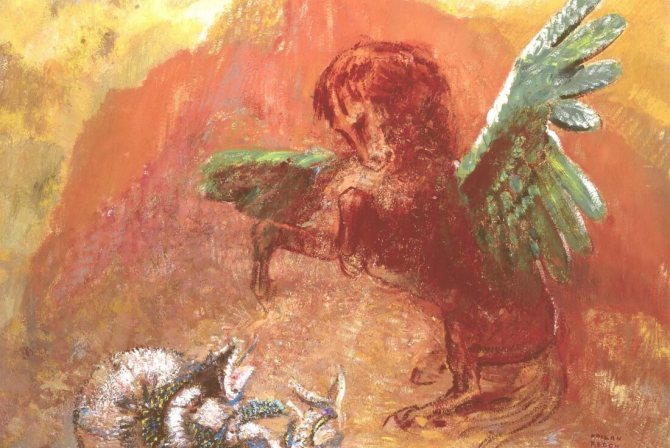
Odilon Redon "Pegasus and Hydra", 1907 Location: Kröller-Müller Museum, Otterlo, The Netherlands
The Origin of Pegasus
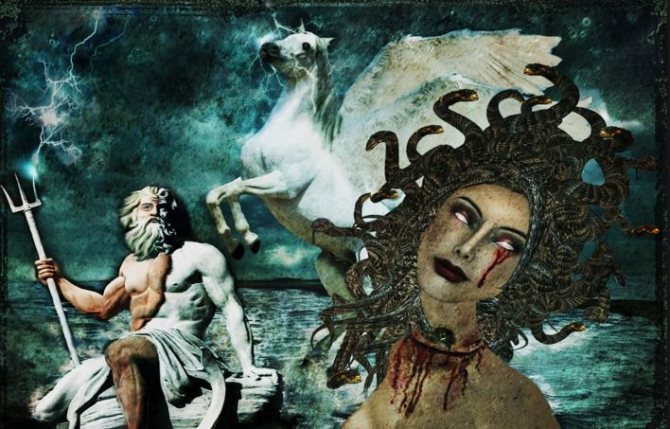

The origin of Pegasus is inextricably linked to the legends of Medusa Gorgon and Perseus, which you can read about in the articles by clicking on the names of these characters above. We will not retell both of these stories in detail, but we will briefly run through them, for the appearance of Pegasus into the world is inextricably linked to them.
In fact, the legend says that originally Medusa Gorgon was not horrible monster, instilling terror into the hearts of people who were petrified at the sight of her. Medusa was known as an incredible beauty, proud and arrogant. Then one day, Poseidon himself fell in love with her. But the proud Medusa Gorgon rejected the advances of the sea lord. Then the god of the seas and oceans decided to take her by force. Medusa tried to hide in the temple of Athena, but Poseidon caught her there and raped her, leaving her with his seed. Athena, because Medusa had so defamed her temple, turned her into a horrible monster and none of the gods interceded for the beauty...
Apparently, Medusa renounced her past when she became a monster. Hatred of humans and gods so badly consumed her that there was almost nothing human left in her, and from this she could not give birth, for Poseidon still did his work and she became pregnant. But even outwardly her pregnancy proceeded differently from that of humans and gods. No one and nothing could have been born in the usual way of such a terrible creature...
As we all know, Medusa and her sisters (who shared the curse with her sister) took refuge on a distant island. It was originally familiar to humans, but Medusa's gaze destroyed all life on it. Everyone has forgotten that it once existed and the memory of it has been erased. However, Perseus, who has made a commitment to Polydectus, manages to outwit the Grai, the other 3 Gorgon sisters, and discovers where the mysterious island is. With the advice of the gods and their artifacts, he managed to decapitate Medusa.
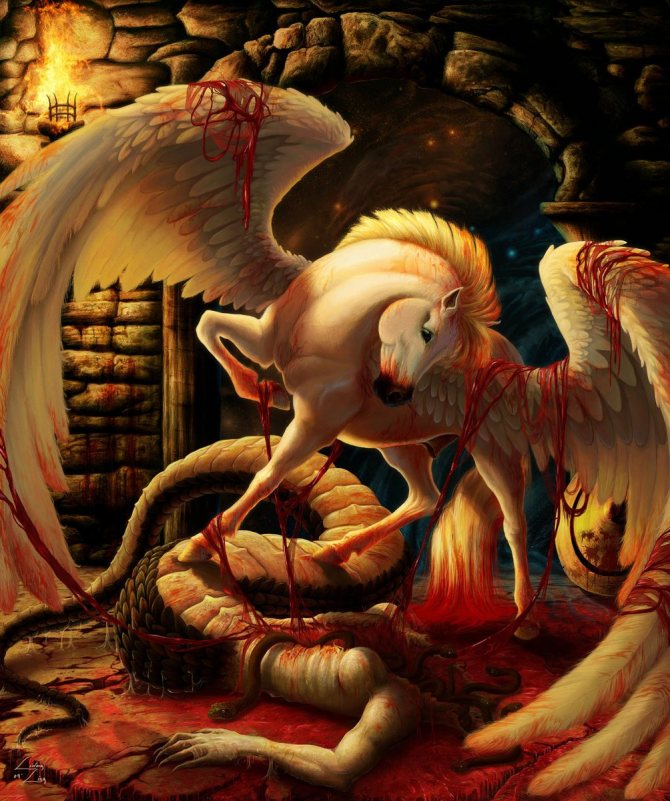

And here begins the story of Pegasus, for as soon as Medusa lost her head, the beautiful winged horse Pegasus and the giant Chrysaor emerged from the cut. Neither the horse nor the giant interested Perseus, so he took Medusa's head and flew away on winged sandals, while Pegasus continued his story already alone. Thus, we can summarize that Pegasus is not just a mythical creature, it is a descendant of the gods, as. Medusa was also of divine origin, albeit of minor importance, and Poseidon is one of the 3 rulers of the world, lord of the depths of the sea and older brother of Zeus himself.
Pegasus, the favorite of the Muses and the helper of the heroes
The beautiful winged horse immediately became the favourite of the Muses. He flew freely in the sky, becoming a cherished dream of many hunters. Many people dreamed of capturing Pegasus, trapping him and turning him into a riding animal.
But the skittish Pegasus was not as simple as it seemed. He deliberately let the hunter get closer and closer to him. At the moment when a hunter's hand touched his soft wool Pegasus suddenly jumped up and flew away.
The sky was his home. Even today, among the stars you can see the constellation of the same name, which in people's imagination resembled the outlines of a horse.
In the myths Pegasus often appears as a minor character, but his help to the main characters is simply invaluable. For example, it was Pegasus who helped Perseus rescue Andromeda. The winged horse obeyed Bellerophonte, who managed to defeat him on the advice of Athena Pallada.
Only thanks to the help of Pegasus, Bellerophonte was able to defeat the terrible monster - Chimera, which was a nightmare for the inhabitants of a region of Greece. Except that I want to point out that Bellerophonte's sense of Pegasus' patron saint led to irreparable mistakes.
The hero, who felt himself equal to the gods, decided to climb Mount Olympus. Moreover, he could well do it, because he had a faithful winged horse. The flight was very successful, but the gods themselves decided that no mortal would dare to challenge them.
The Olympians created a gadfly that flew to the horse and bit it. Feeling the pain, Pegasus stood on his haunches and threw Bellerophonte to the ground. Mutilated and blind, the cripple was abandoned by the gods. Later Pegasus is mentioned in the myths of Eos, the goddess of dawn. Beautiful and youthful, she rides it across the sky, alerting the people of the imminent dawn.
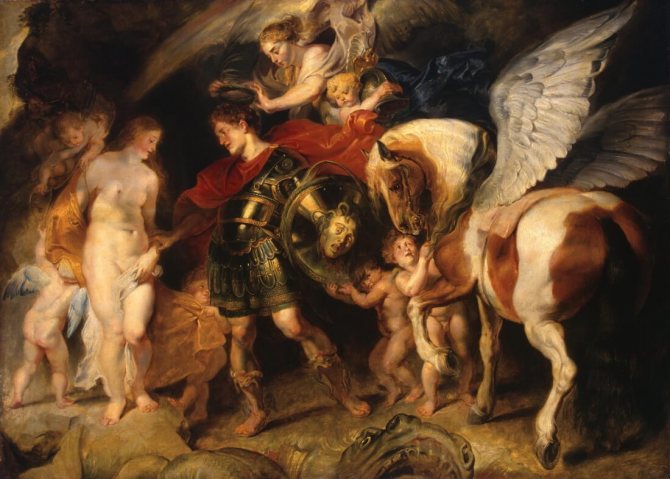

Peter Paul Rubens "Perseus frees Andromeda," ca. 1622 Location: Hermitage, St. Petersburg, Russia The painting was acquired from the collection of Count G. Bruhl in Dresden
Pegasus in other mythologies of the world
At the very beginning of our article we wrote that Pegasus is an amazing creature that is mentioned in various mythologies of the world.
Scandinavian Mythology
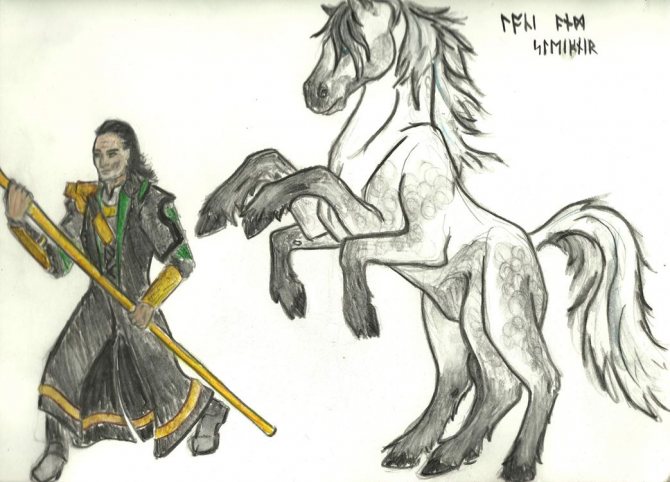

For example, Scandinavian mythology has its own winged horse, Sleipnir, who was born by Loki, who seduced the horse giant so that the latter would not finish building the walls of Asgard in time. Loki did well that the stallion of the giant impregnated him and subsequently Loki still gave birth to the winged and eight-legged stallion, who was named Sleipnir.
Tulpar
Tulpar is a winged horse mentioned in Kazakh, Bashkir, Tatar and Kyrgyz mythologies. But despite the difference in distance, in Central Asian mythologies Tulpar performs the same role as Pegasus in ancient Greek mythology. Only the horse helps Batyr, gives him advice, carries him through the air, cuts out lightning on his own, helps him in battles and battles and is also able to cut out sources of inspiration for the Sesen.
Chinese Mythology
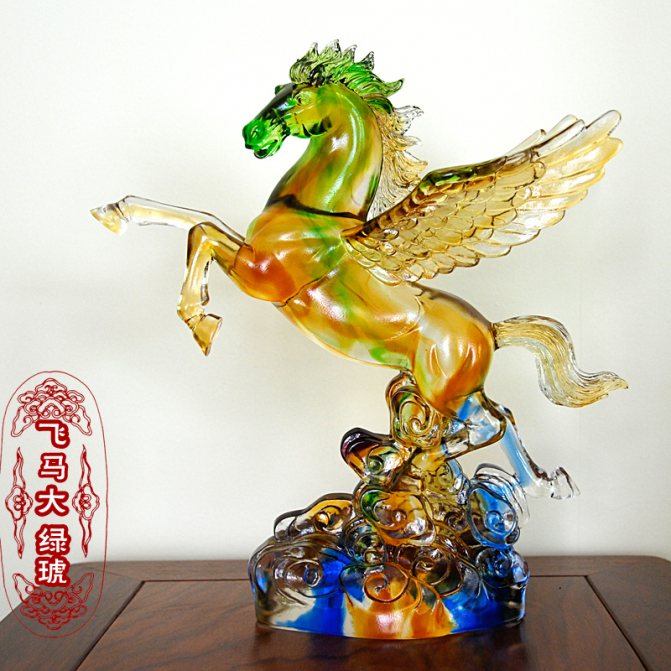

Winged horses are also mentioned in Chinese mythology. According to legends, it was such a horse in his flight that marked the future location of the Great Wall of China.
It is also worth noting that Pegasus is often mentioned in modern art as well. He is often depicted as a magnificent and beautiful creature. In addition, based on the appearance of Pegasus was invented the appearance of the hippogriff, which is mentioned in the same fairy tale of Harry Potter.
This brings our article to a close. We hope you enjoyed it and that you found in it what you were looking for. Don't forget to share the article with your friends and acquaintances, and also write in the comments who else you want us to write about. We bid you farewell, and good luck and see you all again.
Appearance and Habitats of Pegasus
Undoubtedly, Pegasus was an incredibly beautiful animal. But how did the ancient Greeks imagine him? In the imagination of ancient authors Pegasus appears as a winged snow-white horse. Sometimes the myths talk about the sparkling golden fur of the beast.
Pegasus was able to fly higher than the highest mountain peaks. He often climbed to Olympus itself. It was Pegasus who played a special role in creating Mount Helicon. Legend has it that the singing of the Muses caused the rock to start stretching upwards, as if to grow.
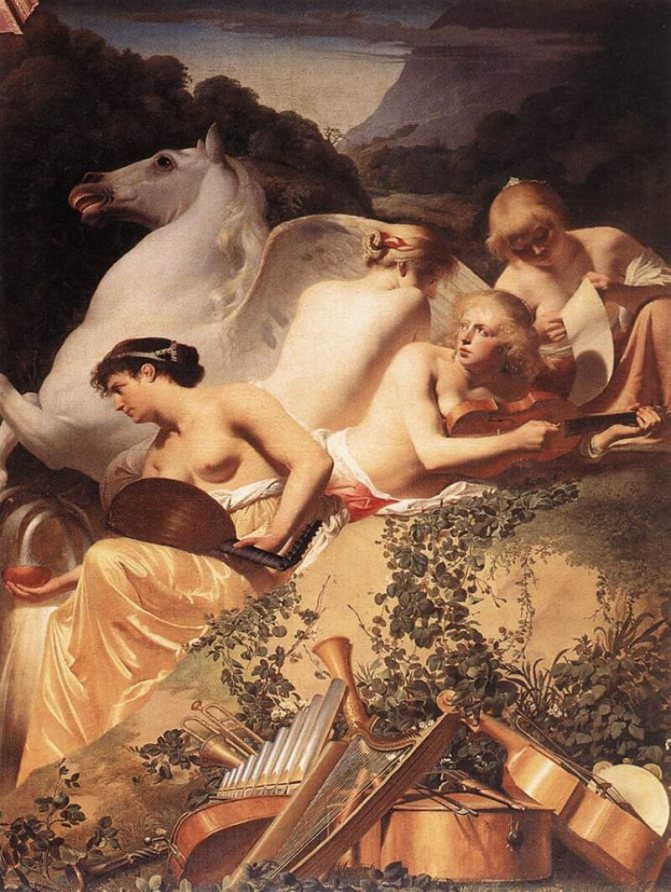

Caesar van Everdingen "Four Muses with Pegasus", ca. 1650 The painting is in the residence of the Heuss-en-Bos in The Hague, The Netherlands
Poseidon was excited by such a phenomenon, and at his command Pegasus struck the top of Helicon with his hoof. The mountain froze, ceasing to grow, and in the place where the hoof of the winged horse hit, a magical spring appeared.
It is Helicon that is one of Pegasus' habitats. He also likes to spend time on Parnassus. These mountains are considered to be sources of inspiration for poets. It was believed that a creative person visiting Parnassus or Helikon, would surely meet his Muse. If you drink water from the "Key of the Horse" on Helicon, the inspiration will not leave the master at all.
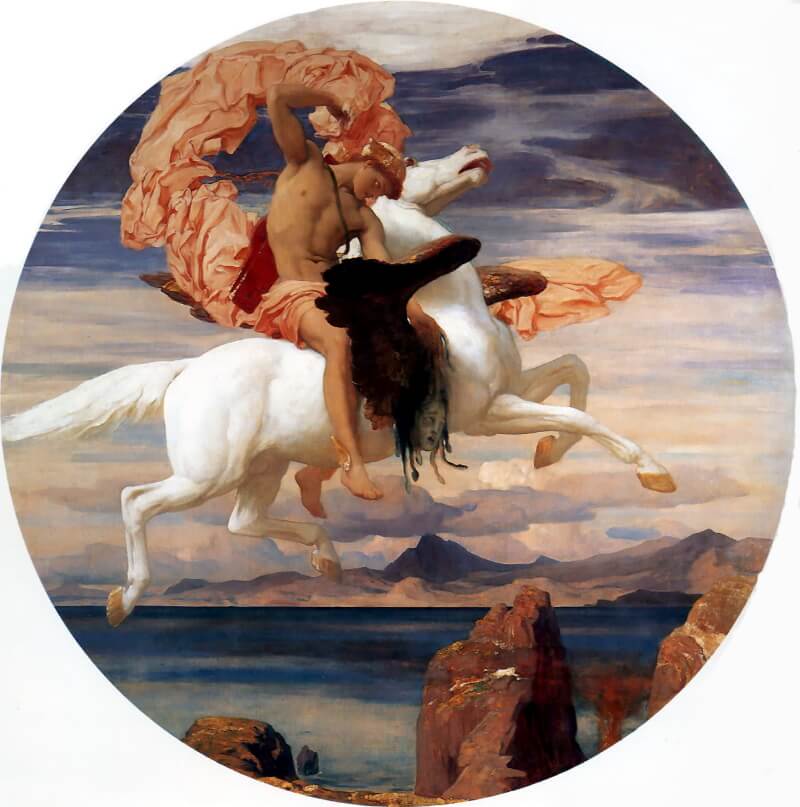

Frederick Leighton, "Perseus on Pegasus rushing to the aid of Andromeda," circa 1896
Pegasus was considered the favorite of the Muses and the patron saint of poets for a reason. His wings remind us of birds that easily overcome earth's gravity. Like ideas and creative ideas Pegasus flies freely forward, not knowing about obstacles. Like the inspiration of a poet, the winged horse is light and indomitable.
From ancient times to this day, the expression "Riding Pegasus" has been used. It is associated with creative people who have managed to find their vocation. It is as if such people rise above the commonplace, giving free rein to inspiration and becoming creators of beauty.
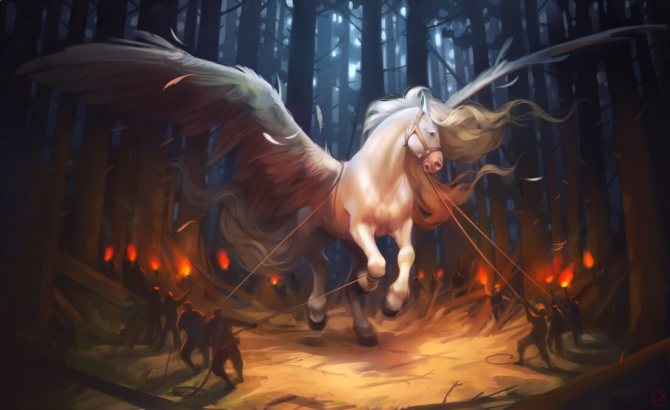

Pegasus - a symbol of indomitability, freedom, beauty and inspiration © Alexandra Khitrova / gaudibuendia.artstation.com
Pegasus is one of the most extraordinary creatures created by human imagination. But if griffins, sphinxes, sirens can be called monsters, Pegasus is a manifestation of bright and beautiful inspiration, which allows us to gain wings - even if invisible.
In the myths of ancient Greece Pegasus is shown as a peaceful creature, an assistant to heroes and gods. He did not take part in any large-scale or extremely significant events, but despite this, the role of Pegasus cannot be diminished, because without him there would not have been beautiful creations, works of art, generated by winged inspiration.

